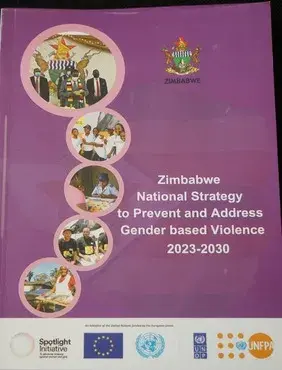Although significant progress has been made towards the reduction and ultimately elimination of GBV and harmful practices, significant challenges remain. These include among others: insufficient implementation of GBV related laws and policies owing to weak accountability mechanisms; human and financial resources capacity constraints among GBV stakeholders and service providers; pervasive patriarchal values, attitudes and practices; inadequate funding of the GBV national response; weak coordination of the national GBV response; and limited awareness of GBV laws, rights and availability of services leading to poor help seeking behaviour. It is against this backdrop that this National GBV Strategy provides a guiding framework for the national response to Gender Based Violence (GBV) in Zimbabwe.
The Strategy sets out GBV priority areas for the country and outlines specific actions and strategies that the Government of Zimbabwe, development partners, Civil Society Organisations (CSOs), independent commissions, private sector and community actors should embark on to prevent and respond to GBV in general and Violence Against Women and Girls in particular. The strategy recognises that GBV is a complex, pervasive, multi-faceted phenomenon that intersects with a broad range of social variables and therefore requires a multi-sectoral and well-coordinated response. The Strategy was developed through a consultative and participatory process involving key stakeholders drawn from Government Ministries, Departments and Institutions; Independent Commissions; Development Partners; UN agencies; Civil Society Organisations; International and Local Non-Governmental Organisations (NGOs); academic institutions; SADC Gender Directorate; traditional leaders; faith-based organisations; media; and the private sector. The Strategy is aligned with government priorities on eradication of GBV and in particular, was informed by and is aligned with the HLPC on Ending GBV and Harmful Practices.
Vision, Goal and Objectives of the Strategy
The Vision of the strategy is “A gender-just society free from all forms of GBV and Harmful Practices by 2030” while its goal is to achieve a 30 percent reduction in the prevalence of all forms of Gender Based Violence and Harmful Practices by 2030. The Strategy has the following six objectives:
a) To promote prevention and early identification of all forms of Gender Based Violence
b) To strengthen the delivery of effective, accessible, and responsive protection, care and support
services to those affected by Gender Based Violence
c) To ensure that all humanitarian, disaster and conflict response actors integrate GBV prevention and
mitigation measures in their work
d) To strengthen national and sub-national capacity to efficiently and effectively respond to Gender
Based Violence
e) To strengthen data collection, research, information, and knowledge management systems
f) To ensure efficient, accountable, and effective management, coordination and partnerships
building for the sub-national and national gender-based violence response
g) To mobilise adequate resources for effective implementation of the National GBV Response


